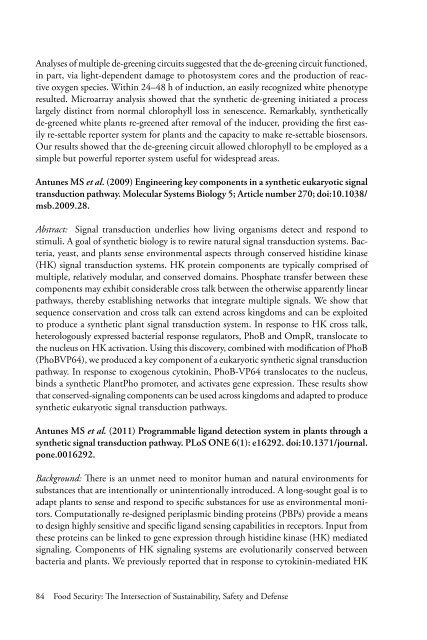Food Security - National Agricultural Biotechnology Council ...
Food Security - National Agricultural Biotechnology Council ...
Food Security - National Agricultural Biotechnology Council ...
- No tags were found...
Create successful ePaper yourself
Turn your PDF publications into a flip-book with our unique Google optimized e-Paper software.
Analyses of multiple de-greening circuits suggested that the de-greening circuit functioned,in part, via light-dependent damage to photosystem cores and the production of reactiveoxygen species. Within 24–48 h of induction, an easily recognized white phenotyperesulted. Microarray analysis showed that the synthetic de-greening initiated a processlargely distinct from normal chlorophyll loss in senescence. Remarkably, syntheticallyde-greened white plants re-greened after removal of the inducer, providing the first easilyre-settable reporter system for plants and the capacity to make re-settable biosensors.Our results showed that the de-greening circuit allowed chlorophyll to be employed as asimple but powerful reporter system useful for widespread areas.Antunes MS et al. (2009) Engineering key components in a synthetic eukaryotic signaltransduction pathway. Molecular Systems Biology 5; Article number 270; doi:10.1038/msb.2009.28.Abstract: Signal transduction underlies how living organisms detect and respond tostimuli. A goal of synthetic biology is to rewire natural signal transduction systems. Bacteria,yeast, and plants sense environmental aspects through conserved histidine kinase(HK) signal transduction systems. HK protein components are typically comprised ofmultiple, relatively modular, and conserved domains. Phosphate transfer between thesecomponents may exhibit considerable cross talk between the otherwise apparently linearpathways, thereby establishing networks that integrate multiple signals. We show thatsequence conservation and cross talk can extend across kingdoms and can be exploitedto produce a synthetic plant signal transduction system. In response to HK cross talk,heterologously expressed bacterial response regulators, PhoB and OmpR, translocate tothe nucleus on HK activation. Using this discovery, combined with modification of PhoB(PhoBVP64), we produced a key component of a eukaryotic synthetic signal transductionpathway. In response to exogenous cytokinin, PhoB-VP64 translocates to the nucleus,binds a synthetic PlantPho promoter, and activates gene expression. These results showthat conserved-signaling components can be used across kingdoms and adapted to producesynthetic eukaryotic signal transduction pathways.Antunes MS et al. (2011) Programmable ligand detection system in plants through asynthetic signal transduction pathway. PLoS ONE 6(1): e16292. doi:10.1371/journal.pone.0016292.Background: There is an unmet need to monitor human and natural environments forsubstances that are intentionally or unintentionally introduced. A long-sought goal is toadapt plants to sense and respond to specific substances for use as environmental monitors.Computationally re-designed periplasmic binding proteins (PBPs) provide a meansto design highly sensitive and specific ligand sensing capabilities in receptors. Input fromthese proteins can be linked to gene expression through histidine kinase (HK) mediatedsignaling. Components of HK signaling systems are evolutionarily conserved betweenbacteria and plants. We previously reported that in response to cytokinin-mediated HK84 <strong>Food</strong> <strong>Security</strong>: The Intersection of Sustainability, Safety and Defense















